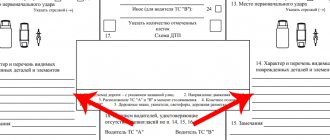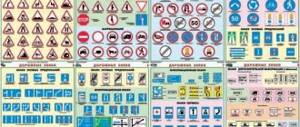OSAGO
The decoding of the abbreviation OSAGO sounds like Compulsory Auto Civil Liability Insurance. A car is a source of increased danger to others, so its owner insures his property against the possibility of damage. OSAGO is insurance that covers damage caused to someone while driving a car. Compulsory car insurance has existed in our country for more than 15 years and has been continuously improved all this time. Lawmakers, automobile experts, and ordinary drivers criticize the system, accusing insurers of trying to profit from ordinary citizens. On the contrary, companies talk about the unprofitability of this type of activity. In this article we will not discuss who is right. Let's look at the difference between CASCO and MTPL and tell you about the main features of each type of insurance.
The bottom line is in simple terms: what is OSAGO?
OSAGO is the most popular motor third party liability insurance contract . This is explained very simply - this policy is mandatory, and every driver must purchase it. For the absence of a document, the law provides for a fine.
OSAGO stands for compulsory motor vehicle liability insurance.
The concept of “motor civil” means that the policy will not cover damage to the vehicle of a participant in an accident; it covers the driver’s liability, and for damage to both the other car and the driver or passengers. With this type of insurance, the person at fault for the accident does not receive any payment. The culprit repairs his car at his own expense.
One of the features of compulsory motor liability insurance is the publicity of the contract .
That is, the driver can contact any insurance company, and they cannot refuse to conclude an agreement. Please note that refusal to issue a policy is fraught with a large fine for the insurer. We invite you to watch a video about what MTPL is:
CASCO and OSAGO, what is the difference?
Under the MTPL policy, damages to victims of road accidents are paid. If an accident occurs due to the fault of the policyholder, the company sends for repair the car that was damaged by the owner of the MTPL policy. In this case, he himself does not receive compensation and restores his vehicle at his own expense. Under the CASCO policy, the car owner is compensated for the repair of his damaged vehicle. This is precisely the difference between compulsory and voluntary types of insurance. It is wrong to discuss which is better OSAGO or CASCO? These are different types of insurance that do not replace, but complement each other.
Is it possible to receive payments under both policies?
In accordance with the legislation of the Russian Federation, receiving compensation payments by one person under two different agreements is strictly prohibited. Thus, being the injured party, a person will have to make a choice: to compensate for damage under a motor vehicle insurance policy, where the maximum amount does not exceed 400 thousand rubles, or to cover material damage with the help of his CASCO insurance.
Ignoring this rule entails administrative liability for the person injured in an accident. The fine for such fraud sometimes exceeds the total cost of repairing the vehicle. Therefore, an attempt to deceive the insurance company in this way is very doubtful for an ordinary driver.
We learned how CASCO or OSAGO works in case of an accident, and what criteria should be used to select a suitable policy. In conclusion, it remains to add that all car owners are required to obtain a motor vehicle license, while a person draws up a complex agreement at his own discretion. Therefore, there is no point in choosing the best type of protection. Indeed, in extreme cases, the driver will simply have to have two insurance policies at the same time, but not one of them.
Limits of liability
The MTPL law now provides liability limits: 500 thousand rubles. for compensation for damage caused to the life and health of the victim in an accident, and 400 thousand rubles. for compensation for damage to property. If several people or cars were injured in an accident, then these amounts apply to everyone.
In approximately 90% of cases, this money is enough to compensate for the damage. But if a serious accident occurs and expensive cars are involved, then the amount of damage may exceed the limits provided by law. In this case, the insurance company covers the costs within the agreed limits, and the person responsible for the accident pays the amount exceeding the limits.
It is possible to protect yourself from serious expenses in the event of major damage. To do this, you need to apply for an extension to your MTPL policy. The car owner receives an additional insurance policy. If an insured event occurs and the calculation of damage exceeds the limit under compulsory motor liability insurance, then part of the money will be paid within the framework of compulsory motor liability insurance, and the excess amount will be paid under an additional compulsory motor liability insurance extension policy.
Not all companies enter into OSAGO extension. Before completing a transaction, it is necessary to check the policyholder. This is a necessary measure, since many scammers have settled in the MTPL market.
When is OSAGO more profitable?
In turn, it is better to prefer applying for compulsory motor liability insurance in the following situations:
- you are a victim of an accident and understand that if you apply for Casco, the price will rise next year, but compulsory motor liability insurance will not,
- you want to receive payment instead of repairs, and in some cases, under compulsory motor liability insurance, this is how compensation for damage occurs, in turn, under the Casco agreement, only repairs are clearly stated for you,
- you have entered into a voluntary insurance agreement with a deductible, and do not want to partially pay out of your own pocket,
- you have drawn up a European protocol, and your contract does not provide for such registration of an insured event,
- your car is less than 2 years old, and under compulsory motor liability insurance you are legally required to be sent to a dealer for repairs, while under property insurance, you are required to be sent to any car service center.
What does the cost of compulsory motor insurance depend on?
The price of the policy is influenced by many factors: region of registration, vehicle power, age and driving experience of people allowed to drive, accident-free driving rate. The risk group includes young people under the age of 22, beginners with less than three years of driving experience.
The accident-free driving rate decreases with each break-even year and increases sharply if the payment was due to the fault of the policyholder. If several people are included in the policy, then when calculating the final amount, they are equal to the worst. Therefore, it does not always make sense to include someone in the policy “just in case.”
The policy can be with a certain number of people allowed to manage it and without limiting them. In the second option, the price of the policy is as high as possible, since the highest coefficients of accident-free driving, length of service and age are taken. There is an important nuance: if a person regularly purchases an MTPL policy without restrictions on those allowed to drive and his data does not appear in the MTPL policy, then his accident-free driving ratio not only does not increase, but also returns to the base indicator after a few years. Thus, it turns out that a policy without restrictions on those admitted to management can be beneficial in one situation, but unjustifiably expensive in another.
From 2021, the so-called “tariff corridor” began to operate: insurers have the right to increase their tariffs by 20% up and down from the size of the basic prices. The age-experience coefficient is calculated more individually.
An insurance agent from FAVORIT MOTORS Group of Companies will help you choose the best option for purchasing a MTPL insurance policy. Our specialists undergo special training and are well versed in all the nuances of the insurance market.
What is needed to apply for compulsory motor liability insurance?
It is enough to present documents for the car and indicate the details of the driver’s license of people allowed to drive. The MTPL rules stipulate that the insurer has the right to inspect the vehicle. In practice this is rarely done. This point exists to combat fraudsters who, without repairing the car, simulate fake accidents. Also, sometimes an inspection is required in order to find a reason and refuse to issue a policy. Often insurers do not like to issue compulsory motor vehicle liability insurance for motorcycles and ask to see it.
What is better to choose for yourself
If with regard to compulsory motor liability insurance everything is clear - take it in any case and renew it in advance, then with CASCO everything is not so clear. It is not advisable to purchase it for an old car, since the price will be simply exorbitant. But for a new expensive and credit vehicle, especially a motorcycle, this will be a good deal, since it is precisely such objects that fall into the risk zone.
Article on the topic: Peculiarities of the activities of lawyers under CASCO
To summarize, we recommend that drivers carry both policies with them. Their combination is excellent protection against almost all incidents that can happen on the road, in a parking lot, in a garage and other critical situations related to the operation of a vehicle.
Technical inspection
Cars that are three years old do not require a technical inspection when taking out a compulsory motor liability insurance policy. Older cars need to come to an inspection point, where specialists will assess the condition of the car. The diagnostic card for cars aged 3 years is valid for two years; older cars must be inspected annually.
At all FAVORIT MOTORS Group dealerships you can undergo a technical inspection. Moreover, our clients can receive the document required to purchase an MTPL policy after scheduled maintenance.
Refusal to pay damages
The Rules and the MTPL insurance contract list cases when the company refuses compensation for damage. The insurance company will not pay if the car was damaged during competitions, tests or training driving, cargo defects appeared during loading or unloading, money, antiques, works of art, and jewelry were damaged during the insured event.
There are also cases when the company compensates for the damage to the victim, but then has the right to demand that the culprit of the accident return the money spent:
- the harm was caused intentionally;
- the person responsible for the accident was intoxicated;
- the culprit of the accident did not have the right to drive a vehicle;
- the driver fled the scene of the accident;
- the driver is not included in the list of permitted persons (when using a compulsory motor liability insurance policy with a limited number of persons permitted to drive);
- the insured event occurred when using the vehicle during a period not provided for by the MTPL agreement;
- when filling out the documents independently, the insurer was not sent a copy of the accident form;
- the car was not provided for inspection;
- The diagnostic card has expired for taxis, buses, trucks intended for transporting people carrying dangerous goods;
- when concluding a contract, a person provided false information, which led to an unreasonable reduction in the amount of the insurance premium - for example, they try to save money by indicating their place of residence in a region where compulsory motor liability insurance is cheaper.
What may be the grounds for refusal of insurance payment?
Any car insurance contract contains a clause with possible reasons for refusing to compensate the client for damages or exemption from payments. There are a great many such reasons and there is no point in listing them.
Here are the most popular insurance claim denials:
- violation of traffic rules by the driver, including alcohol or drug intoxication;
- absence from the policy of the person driving the vehicle at the time of the accident;
- storing a vehicle in unguarded parking lots;
- absence or malfunction of the anti-theft system;
- repairing vehicles before they are inspected by a representative of the insurance company;
- violation of the period for filing an insurance claim.
To ensure that the car owner is not denied payments, it is necessary to carefully read the contract and study each clause. Not all insurance companies operate using legal methods. If a car enthusiast has such doubts, it is better to seek help from an experienced car lawyer.
Compensation form for compulsory motor liability insurance
Many scammers have appeared on the MTPL market. Various frauds: false accidents, incorrect assessment of damage, provoking penalties. Therefore, in 2018, “direct settlement of losses” was introduced under OSAGO: the victim’s car is sent for repairs to a technical center with which an agreement was concluded. Direct insurance does not apply to motorcycles and in cases where insurers are unable to send the vehicle for repairs. For example, a damaged car is located in such a remote area that there is not a single service station nearby. Or the car is rare and there are no spare parts for it. In this case, the damage is compensated in money, and the assessment takes into account wear and tear. For example, for an 8-year-old car, the body part will be valued at about half the cost of a new one.
When restoring a car under compulsory motor liability insurance, the damage is calculated in accordance with special reference books updated every 6 months. There are no restrictions on the manufacturer of spare parts, so we install both original parts and products from third-party manufacturers.
What is meant by compulsory motor liability insurance?
Such a concept as compulsory motor liability insurance stands for the following: compulsory motor third party liability insurance.
The latter is regulated and established by relevant law. Responsibility for compliance with MTPL standards rests with the Central Bank of the country and the structures of the Ministry of Internal Affairs. Moreover, the Central Bank also sets tariffs for motor vehicles and regulates the activities of insurance companies.
An insurance policy belongs to the category of public contracts. According to current legislation, each company represented on the insurance market is obliged to issue a policy at the request of a motorist.
The introduction of compulsory motor liability insurance pursued several goals:
- Determining the responsibility of those responsible for the accident.
- Compensation for damage caused to the vehicle.
- Compensation for damage to third parties (drivers, passengers).
The car insurance contract covers the following types of risks:
- Damage to property (vehicle and other) in an amount not exceeding 400 thousand rubles.
- Damage to human health and life in the amount of up to 500 thousand rubles.
Today, legislators are considering the possibility of introducing additional risks and increasing the amount of payments depending on the cost of insurance. However, these issues are currently under discussion and have not been formalized as a bill.
The Central Bank, as noted, sets tariffs.
In other words, when calculating the cost of a car, all insurance companies take into account specific coefficients introduced by the main market regulator.
Therefore, regardless of which insurer the motorist contacts, the amount payable will be the same everywhere.
Settlement of losses under compulsory motor liability insurance is carried out in one of two ways:
- When contacting the company that insured the car damaged in the accident.
- When contacting the company where the car belonging to the person responsible for the accident was insured.
E-OSAGO
Now you can insure a car under MTPL directly at the insurer’s office, use the services of a broker, or purchase a policy remotely. The algorithm is simple: you need to go directly to the website of the company you are interested in or the Russian Union of Auto Insurers, enter data (vehicle approved for driving, technical inspection, etc.), pay the bill and receive a policy.
It is enough to have a printout of the policy with you. If necessary, the traffic police inspector can check the car using the database.
Does CASCO have an abbreviation?
Experts agree that the concept of CASCO has no abbreviation. Although many companies indicate that this is Comprehensive Automobile Insurance Except Liability. But this is not entirely true; rather, it was invented by insurers so that clients better understand what this product includes. As we know, CASCO allows you to protect your car from the most complete range of risks:
- hijacking, theft, theft;
- road accident;
- fire damage due to fire, fire;
- water damage due to flooding;
- natural disasters, natural phenomena;
- damage from objects, animals, people.
CASCO decoding But since the insurance objects are not only cars, but also absolutely any type of transport (motorcycles, buses, sea transport, agricultural, road-working equipment, etc.), it is incorrect to call CASCO only automobile insurance.
Penalty for lack of insurance
Responsibility for the absence of a policy is stipulated by Art. 12.37 Code of Administrative Offences. If the driver is a person who is not included in the policy, they will be fined 500 rubles. If there is no policy at all, then the amount increases to 800 rubles.
The issue of a significant increase in the fine is being discussed. In addition, it is planned to introduce automatic policy availability control. Photo-video recording cameras will send data to be checked against the database for the presence of a compulsory motor liability insurance policy, and if there is no such policy, the owner will receive a “letter of happiness.”
Their decoding
If everything is clear with the abbreviation OSAGO, since it is deciphered in the law on compulsory insurance.
Related article: Features of a CASCO policy for cars over 10 years old
In the interpretation of the normative act, the decoding of compulsory motor liability insurance is as follows:
- O - mandatory;
- C - insurance;
- A - automobile;
- G - civil;
- O - responsibility.
A special feature of this area is unconditional payments to victims of the actions of the policy owner. If he violated the law, then the insurance company has every right to file a recourse against him in order to reimburse the expenses incurred under the contract. Another feature of compulsory motor liability insurance is the obligation of all drivers to carry this policy with them. Its absence is not punishable criminally or administratively, but is punishable by quite significant fines.
A separate topic is what CASCO insurance is, the explanation of the name. It is not officially disclosed anywhere and, accordingly, there are different opinions regarding the meaning of both the whole word and the letters in particular.
According to insurance companies, the abbreviation CASCO is deciphered as follows:
- K - complex;
- A - automobile;
- C - insurance;
- K - except;
- O - responsibility.
At first glance, this interpretation of the term CASCO seems quite logical, but if you look at it, you can immediately see some inconsistencies. Thus, such a concept as “comprehensive” should cover all road users, but applies only to insured equipment. The next nuance in deciphering the CASCO abbreviation lies in the word “automobile”. The fact is that not only cars are protected, but also sea, river, air and rail transport. There is a version that CASCO is translated from Italian “Casco” as “Board”, that is, a vehicle to be protected.
You can find out more about what is included in CASCO insurance here.
Important! Both policies are similar in decoding, but have completely different focus and content in all areas. This must be taken into account by every road user.
What is the difference
Having understood the decoding of OSAGO and CASCO, you should dwell on their fundamental differences.
Related article: Do I need to carry a CASCO policy with me?
For ease of perception, they are presented in the table:
| № | Name | OSAGO | CASCO |
| 1 | Insurance type | Mandatory | Voluntary |
| 2 | What protects | Property of third parties | Own vehicle |
| 3 | Payment amount | Established by the state | Determined by agreement between the insurance company and the client, not limited |
| 4 | Availability of a franchise | No | All types |
| 5 | Tariffs and payment terms | Established by the state | Determined by agreement between the insurance company and the client |
Important! If you have an MTPL policy, it is not necessary to have CASCO insurance. Otherwise, this is considered a violation, since voluntary insurance does not cover liability to third parties.
CASCO
Contrary to popular belief, CASCO is not an acronym. From a grammatical point of view, it is correct to write the word in ordinary letters, since the term comes from the Spanish casco, that is, “helmet,” or the Dutch casco, which means “body.” The capital letters appeared due to a misunderstanding; they began to write them this way to resemble the abbreviation OSAGO. Therefore, various attempts at decoding (for example, Comprehensive Auto Insurance) are, by definition, incorrect. But let's get back to the main thing.
CASCO is a bet between the insurance company and the car owner. If the car is damaged, the company will pay for the damage. If the entire period passes without incident, then the money paid becomes the company’s net profit.
What is the difference between OSAGO and CASCO? The main difference between CASCO and OSAGO is that with CASCO the car itself is insured, and with OSAGO the driver’s civil liability is insured.
CASCO insurance is voluntary, but in some cases it may become mandatory. For example, when buying a car at a car dealership with bank money, the bank requires a CASCO policy. In this way, the credit institution ensures the return of its money. There is no need to go to the bank specifically to draw up the document.
Is CASCO an abbreviation or not?
Many drivers, even if they are owners of a CASCO policy, have no idea whether this is an abbreviation or not.
To simplify their professional activities, insurance agents came up with the following abbreviation: CASCO is Comprehensive Auto Insurance, except for Civil Liability. But there is no such decoding in the legislation; this is completely “folk art”.
Versions of the appearance of the term CASCO
Having learned that CASCO is not an abbreviation, one begins to be interested in the idea of possible versions of the appearance of the term “CASCO”.
There are three main versions of its appearance, and they are all associated with different languages:
- "CASCO" translates to "helmet" or "skull" in Spanish.
- In Dutch, "CASCO" means "hull".
- In Italian "CASCO" means "board".
One way or another, all versions of the translation of this term evoke a feeling of security. This is the main goal of CASCO.
Policy cost
The price of a CASCO policy is influenced by the cost of the car, its attractiveness to car thieves, and the profile of people allowed to drive: age, length of service, data on participation in accidents. Each insurance company has its own statistics, based on which employees calculate the cost of the policy. Therefore, the price of a policy for the same model varies from company to company. The insured amount should not exceed the cost of the car.
Most often, the insurance line is one year, but by agreement of the parties it can change. Insurers do not like short terms, so insurance for a year and 6 months can cost almost the same.
Company bankruptcy
If the policyholder goes bankrupt, the policy expires. In this case, it is possible to demand compensation through the court. Perhaps the bankrupt still has some assets left.
Bankruptcy should not be confused with license revocation. In the first case, the company has no funds; in the second, it simply does not have the right to engage in insurance. Although deprivation of a license is a bad sign. Very often this is followed by bankruptcy. Therefore, if information appears about the deprivation of a license, demand a refund of part of the policy and enter into an agreement with another company.
What is better CASCO or OSAGO?
In general, this question was initially posed incorrectly. Without compulsory motor insurance, the driver does not have the right to travel, so the question of better or worse does not arise here. Both insurances perform different functions. “Avtograzhdanka” protects the interests of third parties who are innocent in creating an emergency situation, and CASCO is a mechanism for protecting the property rights of the car owner.
ATTENTION !!! Therefore, the best option would be to take out both insurances at once.
To determine the need for CASCO insurance, the driver should independently answer a number of questions:
- How often does he drive a car?
- How much driving experience does the driver have?
- Does the car owner live in a village or metropolis?
- How congested are the roads on which the vehicle travels?
- Age of the car?
- Are other people using the car?
A list of these simple questions will allow the driver to soberly assess the risks and possibilities of financial losses in the event of an accident. When this is a resident of a village, who gets behind the wheel of a car no more than once a month and moves around the area where he lives, the question of applying for CASCO insurance may disappear on its own. Although even in this case this policy will not hurt, it is quite possible to do without it.
In a metropolis, on roads with heavy vehicle traffic, the risk of vehicle damage increases significantly. In this case, it is quite difficult to move without CASCO registration. Even drivers with significant experience can become unwitting participants in an accident, because motorists with different levels of training travel on city roads. In winter, when movement is complicated by weather conditions, the risk of becoming involved in an accident increases significantly.
Franchise
This is the obligation of the insured person to bear part of the losses at his own expense. In this way, companies try to avoid paying for minor damage and subsequent minor repairs. The higher the deductible, the cheaper the cost of the policy.
A franchise can be catchy or unconditional. With a conditional franchise, the company is not liable if the loss does not exceed a certain amount. The insurer only pays for major damage.
With an unconditional deductible, a specified amount is always deducted from the damage. For example, the damage amounted to 300 thousand rubles. If the contract states that the franchise is 10 thousand, then they will pay 290 thousand, and 10 thousand will have to be paid at their own expense.
Refusal of compensation under CASCO
In the voluntary insurance system, the rules may differ, so you need to read them carefully.
Most companies will refuse if the driver was drunk or someone who is not on the list of those allowed to drive. There is a certain period within which an incident must be reported. Risk requirements for theft may be specified. For example, you need to return all the keys to your car. Previously, there were requirements for the mandatory presence of a car at night in a guarded parking lot, but now such clauses have already become an anachronism. Car insurance Catalog of new cars Catalog of used carsAsk a question











